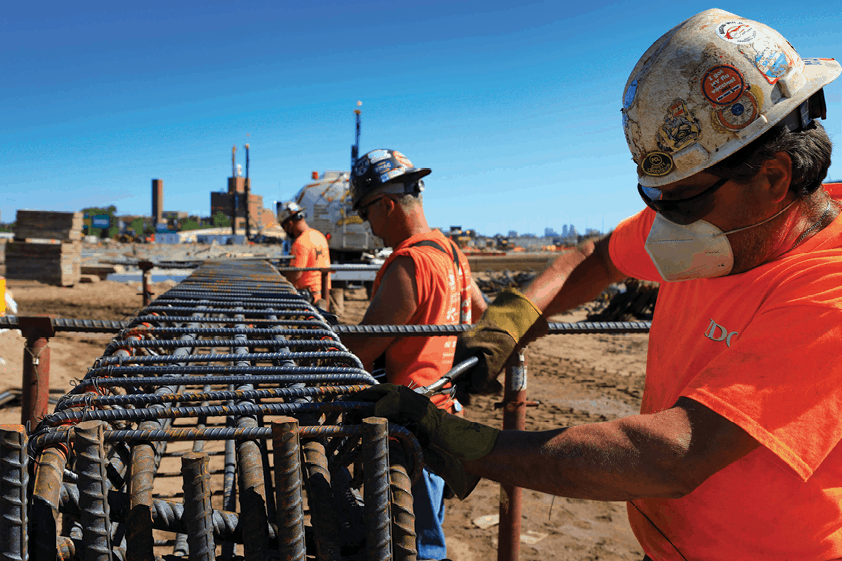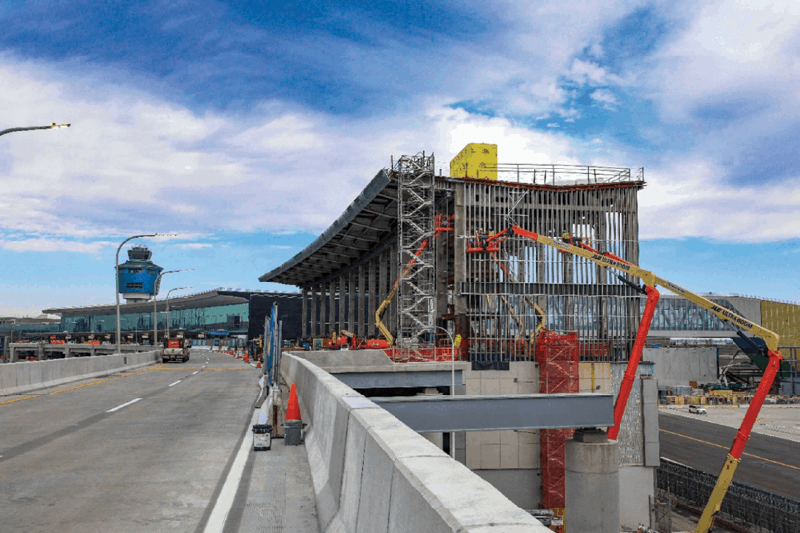
Airports in the United States have numerous stakeholders, with regional agencies and commercial and cargo airlines usually part of the mix. The federal government, via several agencies within the U.S. Department of Transportation or Department of Commerce, also plays a role.
In addition to regional agency or port authority bonds or financing, the federal government often is turned to for funding, and that has proven to be the case as airports and airlines have grappled with a plunge in passenger traffic in 2020 and early 2021 because of COVID-19 concerns and restrictions.
In September 2020, the Trump administration allocated some $1.2 billion in infrastructure grants to airport operators, with then Secretary of Transportation Elaine L. Chao saying, “This $1.2 billion federal investment will improve our nation’s airport infrastructure, enhance safety and strengthen growth in local communities, which is especially important as the economy recovers from COVID-19.”
The Trump administration at that time said it had directed $13.5 billion to America’s airports to improve infrastructure and safety, including about $10 billion in economic assistance relating to the COVID-19 epidemic.
Whether because of government requirements or corporate sustainability targets, many of the subsequent airport and transportation projects will aspire to Leadership in Energy and Environmental Design (LEED) or other green building goals that prioritize recycling.
As contractors and processors of C&D materials survey their regional markets for opportunities in 2021, they may be well-served to stay in touch with developments at airports, train stations and toll roads to make sure they are aware of pending projects and bidding opportunities.
Less volume, fewer hassles
For airlines and airport management agencies experiencing plummeting revenue because of COVID-19, it may be hard to find any silver linings. One of the few may be the opportunity to ramp up renovation or construction projects when there are fewer passengers to notice the disruption.
Projects currently underway at airports were planned well before COVID-19 emerged as a global health crisis. The lack of travel seems to have helped speed up and maintain timetables of many of those projects, however, and the federal government’s willingness to inject cash into the economy is likely to prompt additional efforts in the near future.
For recyclers and contractors who specialize in materials diversion and recycling, the renewed activity has a high probability of including recycling targets set by one or more of the entities involved in overseeing these projects.
One such stakeholder is the Port Authority of New York and New Jersey (PANYNJ), which operates: three international airports (John F. Kennedy, LaGuardia and Newark); two smaller airports; a global seaport network with several terminals; toll roads, bridges and tunnels (see the sidebar “Bridging the diversion gap,” on page 39); bus terminals; the PATH regional train system; and the World Trade Center in lower Manhattan.
Abigail Goldring of the PANYNJ media relations staff says the authority’s Clean Construction Program is tied to its larger commitment to the Paris accord on combatting climate change. “That includes reaching the greenhouse gas reduction goals we set in 2018 when we embraced the tenets of the Paris Climate Agreement: reducing our emissions by 35 percent by 2025 and 80 percent by 2050,” she comments. “We are proud to be a leader in developing and implementing innovative strategies and technologies to help us achieve those goals, including in the areas of green building and clean construction.”
Airport projects in New York and New Jersey are far from the only ones that have pursued or attained LEED certification status, a process that can include earning points by diverting a high double-digit percentage of discarded materials for recycling.
The Washington-based Green Building Information Gateway (GBIG) has identified 26 U.S. airport construction or renovation projects that have attained LEED certification. The West Coast has an outsized presence on the list, with 19 of the projects in the three Pacific Coast states (17 in California and one each in Oregon and Washington).
Some of those projects are smaller and may encompass a single airport lounge. Others are larger, such as the more than 1.2 million square feet of space at the Indianapolis International Airport that opened in 2008. LEED certification also was attained on major projects at international airports in Boston, Miami and Portland, Oregon, according to GBIG.
Green building goals will likely help ensure containers are placed to divert C&D scrap materials to recycling destinations at transportation hubs throughout the U.S. in the near future.

A small but helpful role
The materials recycling aspects of the overall LEED scorecard make up just a small percentage of the points in the scoring system, but the notion of demonstrating visible support for a more circular outcome for debris and scrap tends to make those points a priority at most job sites.
“Sustainability is one of the agency’s six core priorities,” says Goldring. “The newly launched Clean Construction Program will help the Port Authority reduce emissions through several leading initiatives, including diverting waste from landfills,” she adds.
Goldring says PANYNJ is developing new tools to help contractors recycle. “The agency is in the process of developing a Construction Waste Matching Tool and other new technologies to help promote circularity among its large portfolio of transportation facilities,” she notes.
A breakdown of the program that helped the Indianapolis International Airport (IND) attain LEED certification demonstrates some of the ways mixed C&D facility operators and contractors who are familiar with recycling can get involved in airport construction and renovation projects.
According to a news release from Indianapolis International Airport detailing LEED aspects of its construction project, “During construction, the project’s waste recycling program separated and diverted more than half of the project’s construction debris away from landfills for reuse elsewhere.”
Adds the IND airport agency, “The project also reused pavement rubble from demolished roads and taxiways as fill on-site. Overall, use of recycled materials in construction exceeded 27 percent, reducing raw material demand and often requiring less energy than materials derived ‘from scratch.’”
The airport’s managers say the recycling mentality has carried over into day-to-day operations, as “recycling stations are located throughout the airport, and channels [materials] into community recycling programs.”

Sustainability on the passenger manifesto
How many such opportunities emerge in 2021 and 2022, prompted by government stimulus spending, remains uncertain, although the Trump era allocations should provide a boost. As of February, the new Biden administration and new Congress are working their way into federal agency and legislative agendas that may look very different from the four Trump administration budgets that preceded them.
An initial proposal from Democrats in the House of Representatives calls for airline payrolls to be the biggest beneficiary, with a committee in the House recommending a $15 billion allotment to airlines to keep their workforces in place.
Adds the politics-focused website The Hill in a Feb. 9 article, “A measure from the House Transportation and Infrastructure Committee includes $50 billion for a disaster relief fund, $30 billion for transit agencies, $8 billion for airports, $3 billion for aerospace manufacturing and $1.5 billion for Amtrak.”
The PANYNJ is in the midst of renovating the Central Hall at LaGuardia Airport in New York and says it is “embarking on a major modernization and redevelopment effort to position EWR [the Newark, New Jersey, airport] to meet the needs of the 21st century.”
The Newark Liberty Airport project involves installing a “best-in-class arrivals frontage design,” says the authority. The 1-million-square-foot terminal will open in late 2022 “with cutting-edge design changes built into the structure,” says PANYNJ.
In a December 2020 news release, Port Authority Chair Kevin O’Toole states, “The impact of COVID-19 reflects a new reality in how transportation agencies can and must plan for the future. The Port Authority and Newark Liberty are charting a new post-pandemic path by building smart, safe and sustainable features into this impressive new terminal.”
Projects at airports throughout the U.S. are likely to include the word “sustainable” in their description, whether they are pursuing LEED certification or striving to meet other government or corporate sustainability goals that most often include a recycling emphasis.
Speaking about the agency’s willingness to continue to go green in the future, Goldring says, “We look forward to working with the Biden administration on carrying out sustainability initiatives that will reduce greenhouse gas emissions.”
This article originally appeared in the March/April issue of Construction & Demolition Recycling magazine. The author is a senior editor with the Recycling Today Media Group and can be contacted at btaylor@gie.net.
Latest from Construction & Demolition Recycling
- Viably, Turmec partner on Ohio installation
- EPA plans to revisit numerous environmental, climate regulations
- Fornnax wins Green Innovation of the Year award
- ABC: Construction backlog inches lower, staffing levels expected to grow
- Former detention center in Cleveland set for demolition
- Ferrous market upward price momentum continues into March
- Build Reuse joins up for Circularity event
- Komatsu adds 2 wheel loaders to product line





